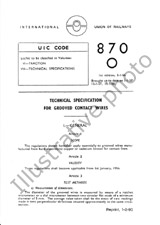We need your consent to use the individual data so that you can see information about your interests, among other things. Click "OK" to give your consent.

UIC B126/DT426-1ed.
Braking Problems - Calculations of the Kappa-factor for G braked trains longer than 700 m
Translate name
STANDARD published on 1.11.2012
The information about the standard:
Designation standards: UIC B126/DT426-1ed.
Publication date standards: 1.11.2012
SKU: NS-1190172
The number of pages: 49
Approximate weight : 147 g (0.32 lbs)
Country: International technical standard
Category: Technical standards UIC
Annotation of standard text UIC B126/DT426-1ed. :
UIC leaflet 544-1 4th edition provides braking distances for G-braked and P-braked trains in relation to their braked weight percentage up till a length of 700 m. For longer trains there exists no unified model to determine the stopping distances with respect to the braked weight percentage.
To respond on the growing interest to operate trains longer than 700 m a model with Kappa values, similar as the existing one for P-brake trains up till 700 m of length, is created with the intention to be integrated in the 5th edition of the UIC leaflet 544-1.
This new Kappa model is made exclusively for G-braked trains because trains longer than 700 m are expected to be operated with the G brake position to avoid excessive longitudinal forces.
The basis for the model are the stopping distances of G-braked trains from ERRI B 126/RP17 and the brake build-up times as determined by workgroup B 126.15D for trains with length up till 1 500 m as described in DT 423.
The necessary Kappa values seemed to be highly dependent on the initial Lambda and the speed of the train. The lower the Lambda and the lower the speed, the lower the Kappa-value should be. Taking the lowest Kappa values was certainly the safest option but low Kappa values would force the trains to run at very low speeds.
Therefore it was necessary to choose the Kappa values on the basis of an evaluation of the safety margins on different networks for all possible speeds. The Kappa values were chosen in such a way that the safety margins remain within acceptable values.
Safety margins being generally higher for low speeds, the Kappa values could be based on the normal operating speeds with the consequence that the safety margins are reduced for the lower speeds.
Due to the large number of variations in signalling systems, it was not possible, within the timeframe of the project, to foresee the exact impact of the Kappa value on the safety margins for all the existing signalling systems.
Depending on the signalling system, corrective measures may be necessary to maintain sufficient safety margins.
Therefore the workgroup recommended limiting the model with Kappa values for G-braked trains up till a length of 1 000 m of the hauled rake.
"+
"
Name:Bremsfragen - Berechnung des Kappa-Faktors für G-gebremste Züge mit einer Länge von über 700 m|
Das Merkblatt Nr. 544-1, 4. Ausgabe, gibt Bremswege für G- und P-gebremste Züge bis zu 700 m Länge im Verhältnis zu ihren Bremshundertsteln an. Für längere Züge besteht kein einheitliches Modell aur Bestimmung der Haltewege im Verhältnis zu ihren Bremshundertsteln.
Angesichts des verstärkten Interesses am Betrieb von Zügen über 700 m, wurde analog des existierenden Modells für P-gebremste Züge bis 700 m ein Kappa-Modell für G-gebremste Züge erstellt, das in die 5. Ausgabe des UIC-Merkblatts Nr. 544-1 eingearbeitet werden soll.
Dieses neue Kappa-Modell gilt ausschließlich für G-gebremste Züge, da zur Vermeidung übergroßer Längsdruckkräfte Züge über 700 m Länge in Bremsstellung G eingesetzt werden sollen.
Basis sind die Haltewege der G-gebremsten Züge aus dem ERRI B 126/RP 17 sowie die Bremsentwicklungszeiten, die von der AG B 126.15D für Züge bis zu 1 500 m im DT 423 beschrieben wurden.
Der erforderliche Kappa-Faktor schien stark von den Ausgangslambdawerten und der Geschwindigkeit des Zuges abzuhängen. Je niedriger der Lambdawert und je niedriger die Geschwindigkeit, desto niedriger der Kappa-Wert. Die sicherste Option wäre die Auswahl des niedrigsten Kappa-Faktors gewesen, allerdings zwingen niedrige Kappa-Werte zum Betrieb mit sehr niedrigen Geschwindigkeiten.
Daher mussten die Kappa-Faktoren auf Grund einer Bewertung der Sicherheitsmargen der einzelnen Netze für alle Geschwindigkeiten bestimmt werden. Sie wurden so ausgewählt, dass die Sicherheitsmargen in einem akzeptablen Bereich liegen.
Da in der Regel die Sicherheitsmargen bei niedrigen Geschwindigkeiten größer sind, konnte bei der Bestimmung der Kappa-Faktor von den normalen Betriebsgeschwindigkeiten ausgegangen werden, wodurch sich kleinere Sicherheitsmargen für niedrige Geschwindigkeiten ergaben.
Auf Grund der vielen verschiedenen Signalsysteme war es im Rahmen der vorgegebenen Projektlaufzeit nicht möglich, die exakten Auswirkungen des Kappa-Faktors auf die Sicherheitsmargen der einzelnen Signalsysteme vorherzusagen.
Je nach System können korrektive Maßnahmen erforderlich sein, um eine ausreichende Sicherheitsmarge zu gewährleisten.
Daher empfiehlt die Arbeitsgruppe, das Modell mit Kappa-Faktoren für G-gebremste Züge auf Wagenzuglängen bis 1 000 m zu begrenzen.
"+
"
We recommend:
Updating of laws
Do you want to be sure about the validity of used regulations?
We offer you a solution so that you could use valid and updated legislative regulations.
Would you like to get more information? Look at this page.



 Cookies
Cookies
